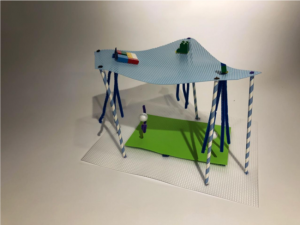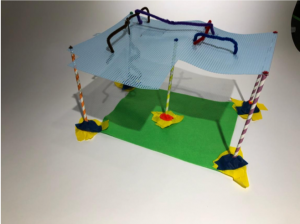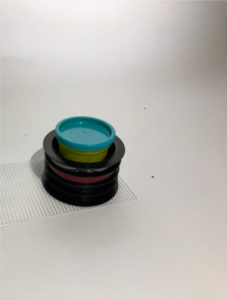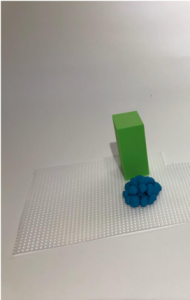Solar Studios MSR Blog Post
Before beginning ideation, we narrowed our how can we statement to: how can we help the Rice community become more aware of their water consumption through an installation art piece at the Solar Studios? We also finalized four specific design goals for our installation:
- Successfully built and installed in the Solar Studios space by April 20th
- Appeals to a broad audience
- Has visibility on campus/is visited by Rice community
- Impacts visitors in some way – emotional reaction, change in individual behavior, or action by university administration.
After narrowing our problem space, hcw, and design goals, we began ideation. Because our project is an art installation with fewer constraints than most, we chose to cluster our ideas around guiding themes derived from our research: (in)visibility and activism. We found the most compelling theme to be (in)visibility: making the invisible repercussions of our actions on water systems visible. We then chose four of the most promising ideas from this theme and prototyped them.
- 8 gallons/sec
This idea was inspired by the fact that Rice uses approximately 250 million gallons water per year, which we calculated to 8 gallons per second. The prototype shows a low fidelity elevated map of Rice’s campus. Visitors will walk underneath the map and see water streaming from the underside of each building equating to 8 gallons per second. This takes the constant water waste that results from our collective actions and makes it visible.
- Pipes
This prototype is similar to the first, except it shows the university’s water pipe system in place of buildings. By representing the Rice campus in terms of its unseen water pipes, this idea aims to make visitors aware and critical of the infrastructure that facilitates our water consumption. It also plays on a theme that our community partner, Lina Dib, recommended: making the familiar unfamiliar. We hope the visitor’s realization that this mass of pipes is actually the campus they know so well will be a statement on the invisibility and complexity of this system.
- Tension
This prototype tackles the idea of our “water footprint,” or the water used to produce the products we use. We learned that this accounts for 96% of individual water consumption. Because water is used to make nearly all products, we are constantly “consuming” water with our most basic actions, even when it doesn’t seem like it. This prototype seeks to make this constant use visible with water tension. The Play-Doh container represents a basin brimming with water, which will sit in a larger basin that circulates spilt water back through the installation. The perforated surface surrounding the basin represents a pressure-sensitive paneling that will cause the basin to overflow and spill water whenever someone steps on it. The sound of spilling water will be amplified and jar the visitor. This will create an experience in which visitors feel that they cannot help but waste water with even their smallest actions, making the invisible impact of our daily actions visible.
- Water Balloon Fight
This idea illustrates our collective water waste in terms of a Rice cultural artifact. The prototype consists of a pile of small balls of Play-Doh, representing water balloons, and a green rectangular prism representing a television or projection. The pile of water balloons will contain a volume of water equivalent to some significant amount, such as an individual’s daily water usage. The television or projection will display slow-motion videos of the water balloon fight at Beer Bike. This installation would represent a metric of our water waste in terms of a powerful cultural symbol at Rice. It also challenges members of the Rice community to reflect on the impact of its traditions and culture.
MSR Feedback
-Speak louder
-4 ideas are engaging and relatable
-Prototypes were helpful for understanding ideas
-Concerns about wasting water while representing water waste
-Which of these is most feasible by April 20th?



